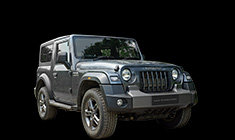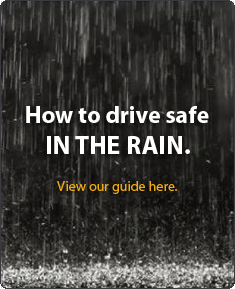News
Microfiber cloths for cars: Types, uses and maintenance
Don't get too carried away with GSM and brands and wanting the most expensive one. After a certain point, they don't matter as much as you think.
BHPian Cresterk recently shared this with other enthusiasts.
Microfibers have become extremely popular in the automotive detailing industry and even with the DIY fellow who likes to wash his car at home. I'm betting pretty much everyone here has at least heard about it, even if they do not understand the differences between them or how to use them properly.
I hadn't really looked too deep into microfibers until I got my car ceramic coated and started washing it myself and as always, I went too deep with the research.
Here are most of the ones I purchased and experimented with over the last year.
All of them have a different purpose and are of varying price points. Don't get too carried away with GSM and brands and wanting the most expensive one. After a certain point, they don't matter as much as you think and while durability varies, they are not meant to last forever. It's better to buy 2-3 cheap ones over one very expensive one. Some of the expensive dual-pile ones can do 2 tasks but there is no such thing as a great all-purpose microfiber that you can use for everything.
Pile
Pile is the term used to describe the long strands of microfiber that you can see. Each of these piles is made up of thousands of individual microfiber threads. The type of pile is what determines the purpose of the microfiber cloth.
Let's start with the most common one
Ultra low pile or No pile

These cloths are what you get with the box when you purchase sunglasses or eyeglasses. They are excellent for trapping and removing human oil and very tiny particles without smearing. Very important for keeping your vision clear. They are also good for cleaning your laptop screens, phones, infotainment or any other glossy surfaces where you end up with fingerprints.
They are useless for anything else.
Low pile or medium pile

Blue low pile microfiber
Running your hand just lightly over them should feel "scratchy" like it's soft velcro. That's because the microscopic hooks in the microfiber are grabbing onto the imperfections on your skin. It's very apparent if you have calluses.
You can use them for removing polish, compounding or waxing residue.

Yellow medium pile microfiber. Notice how the other side of the yellow has a low pile like the blue one. Most higher pile microfiber cloth will have one long pile and one shot pile side.
Dirt or large particles are grabbed very easily due to the velcro effect. However, these large particles are hard to remove once they grab and reusing it without proper cleaning will lead to scratches. Hence why detailers advise you to keep them aside if you drop them. I'm not a fan of throwing brand-new towels away.
They are also good for when you need an extra "bite" when cleaning a dirty car that you won't get from the Chenille wash mitts (noodley mitts)
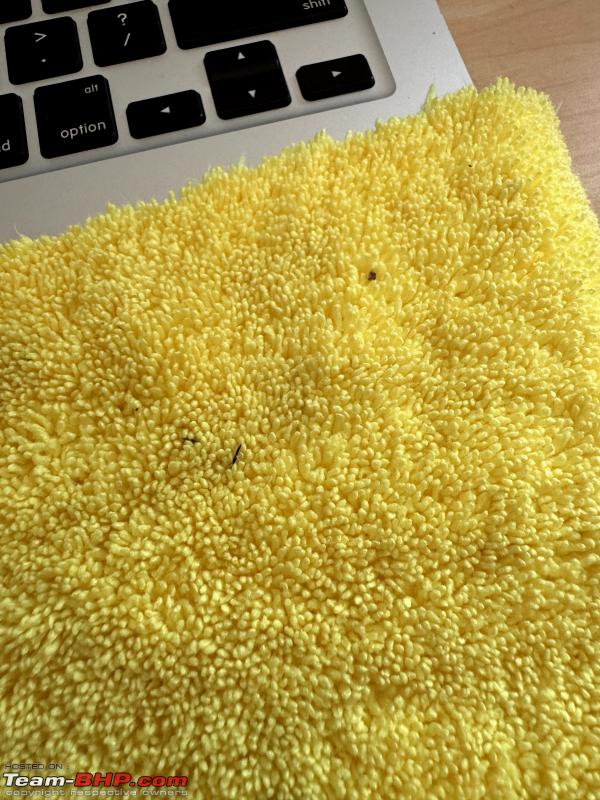
Large, hard particles caught in the medium pile. They will cause scratches if used on paint. They cannot be easily removed with your hand without also ripping out some microfiber with it
I use a medium pile for the interior, mainly cleaning the dashboard, dusting and such.
High pile

Orange high pile towel with a blue low pile towel for comparison
They are very absorbent and can trap most debris safely inside the long strands. This is because they have quite a lot of surface area due to the longer pile.
High pile towels are the only ones you should use on paint for any sort of waterless washing like with quick detail sprays.
PS: Quick detail sprays are only meant for getting off light dust or any spots you missed while you did your normal wash and drying. Do not use it in place of a proper wash.

From top to bottom: medium pile, high pile, low pile
They are also very good for drying and there are special drying towels made out of plush high pile microfiber that can dry a panel completely with just a single swipe and leave no streaks.
However, you cannot use them on glasses like windshields etc or they will leave tiny fibers behind. Glass is a different type of surface and it can rip out tiny little threads of microfiber which will then be seen as lint. For that, we have dedicated glass microfibers.
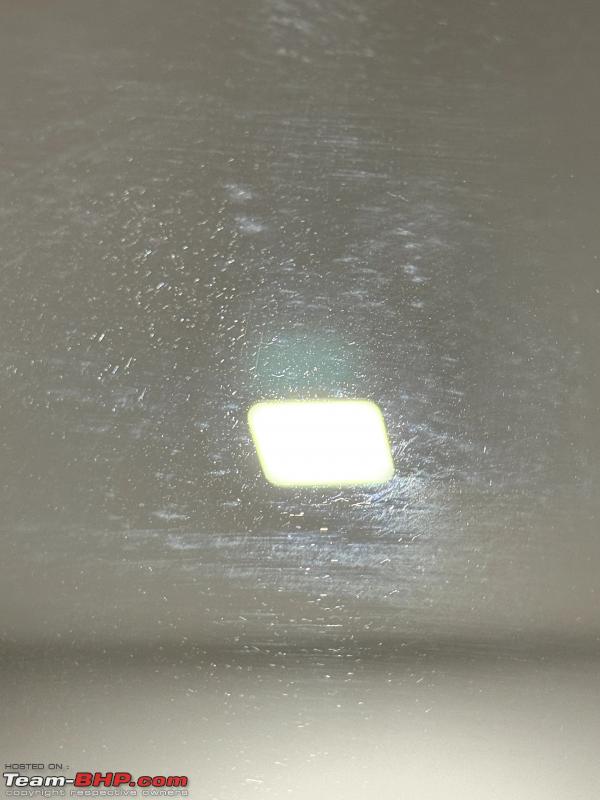
Lint left behind on a mirror when wiped with a non-glass specific microfiber. If you accidentally end up with this kind of linting, just wipe with a no pile towel (listed at the top of this post) to remove them.
Waffle weave
These types of towels are purely for drying. This is not a type of pile but a unique surface pattern. This pattern looks like waffles and allows them to hold quite a lot of water inside the pockets. Once one side is soaked, you can flip them around and use the other side to mop up even more water.

They can also be used for drying glasses and will not leave any lint behind.
They are very cheap compared to plush towels and depending on the size, they can be used to dry almost an entire car without having to wring them out repeatedly!
However:
They are low pile towels. This means it doesn't offer much protection if you use them on a car that isn't washed properly beforehand, you will leave micro scratches. Do not press down on the edges of this towel.

Yellow waffle weave towel I have been using for the past year
They can get most of the water off, but they don't dry perfectly well in one swipe. They can leave small streaks of water behind compared to using an expensive hybrid towel.
Hybrid drying towels:

You can see that this particular towel has alternating columns of low pile and high pile. It can get every bit of water off the paint and leave it perfectly dry in a single swipe. Just spread it out, pat it down and slowly pull it across. The high pile protects the car from most micro scratches even if your washing wasn't perfect.
The other side of the towel has a diamond weave pattern (similar in properties to waffle weave) that can be used to dry glass and windshields.
However, it gets soaked pretty easily and you will be wringing it out a lot. Just drying the car's bonnet (hood) is enough to get it saturated with water and I have to wring it out. It is also expensive.
I personally prefer using a cheap waffle weave towel or an air blower to get the majority of the water off quickly in one go, and then using this towel as a follow-up to get flat surfaces completely dry or on any spots I missed. Saves a lot of time spent on wringing.
Here is a link if you want to get more in-depth about Microfibers.
Now come the Wash mitts. Technically not a towel but they are microfiber in the form of a mitt that you can either wear over your hand or just hold them.
There are many different types.

Note: this image was taken from the web
The only ones I will be covering will be the Chenille wash mitts (the noodle type one on the left) because they are the ones I have been using for the past year. I don't have experience with mitts of the other types.
Chenille Wash mitts
They are the easiest to use for beginners. They have these noodles sticking out of them that move around based on which direction you are swiping. This means a different side of the noodle is contacting the surface when you change directions. This allows you to be less careful of how you are swiping as well as cover a lot more area before having to return to the bucket to clean them. The best part about these mitts is that swishing them around in a bucket of water will remove most of the dirt trapped in them, letting you re-use them. Works even better if you have a grit guard.


They come in two types. One sided and double sided. I recommend getting the double sided ones because you can just flip your hand around and cover even more area before returning to the bucket to rinse off the dirt. They are anyway only marginally more expensive than the single sided ones. The cost will generally determine the amount of soap solution they hold or how many "noodles" they have.
It's good to buy 2 of them. Use one for the top 80% of the car, and another for the bottom 20% which has the most muck and grime.
Other mitts
The one I linked above have held up pretty well for me over the last year so I hadn't really bothered to try other ones. Recently decided to change it up and bought this from a random seller on amazon:

It was cheap compared to equivalent competitors but I'm not sure about the quality or if it is even real microfiber. I bought it because it looked similar to the rightmost one in the first picture. I will not be linking it since I'm not sure if it is legit. I will come back and write more about it after using it for a while.
As I get and try out more brands and varieties of mitts, I will update this section.
Continue reading Cresterk's explanation about microfiber cloths for BHPian comments, insights and more information.



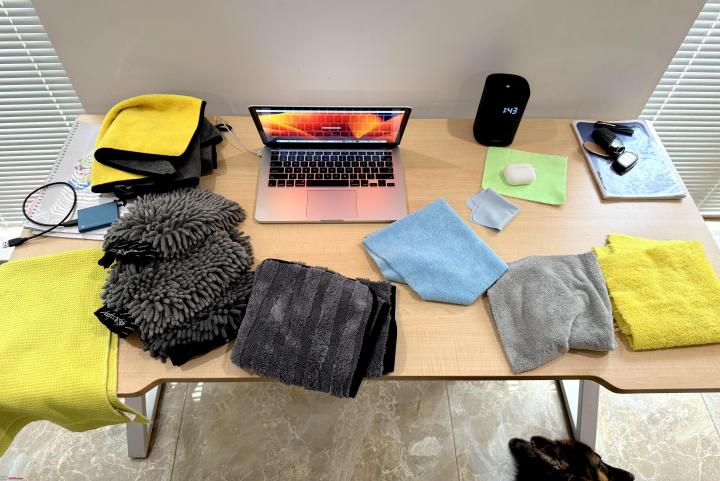


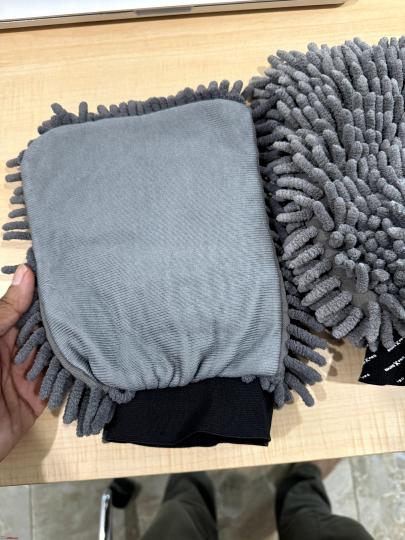





.jpg)









